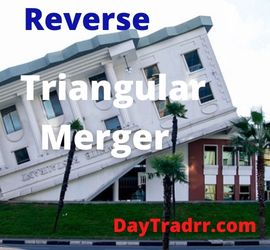What Is a Reverse Triangular Merger?
 A reverse triangular merger occurs when a parent company creates a shell company to acquire a target company. Once the target is acquired, it is absorbed into the parent company as a direct subsidiary.
A reverse triangular merger occurs when a parent company creates a shell company to acquire a target company. Once the target is acquired, it is absorbed into the parent company as a direct subsidiary.
A reverse triangle merger is also known as a reverse subsidiary merger. It is a common acquisition arrangement in which one business buys another utilizing the acquiring firm’s subsidiary. This subsidiary of the acquiring business merges with and into the target firm with the target company surviving the merger. The target company continues to exist as a business entity, but is now, a wholly-owned subsidiary of the purchasing business. This structure achieves the same outcome as if the acquiring corporation purchased all of the acquired business’s equity.
Reverse Triangular Merger – A Closer Look
In a reverse triangular merger, the acquirer establishes a subsidiary that merges with and then liquidates the selling business. It results in the selling firm as the surviving entity and a subsidiary of the acquirer. The buyer’s shares (or cash) are subsequently distributed to the shareholders of the seller. Because the reverse triangle merger keeps the selling company and its commercial contracts, it is more often employed than a direct merger. In a reverse triangular merger, at least half of the payment is in the form of the acquirer’s stock, and the acquirer acquires all of the seller’s assets and liabilities.
In this way, the acquiring business may take ownership of the target company’s non-transferable assets and contracts. This result is not always attainable with conventional acquisition procedures. When it comes to asset transactions, acquirers often have problems transferring contracts. Particularly, contracts with the government or governmental organizations. The disadvantage is that, since it is effectively a stock transaction, the purchasing corporation acquires all of the business’s obligations.
Also, the acquirer must fulfill the continuity of business enterprise criteria. The acquirer must continue the target company’s operations. Or, employ a significant amount of the target company’s business assets in the firm. Furthermore, the buyer must be authorized by both corporations’ boards of directors.
Reverse Triangular Merger – Taxable vs Tax-Free
A reverse triangle merger might be taxable or nontaxable depending on how the transaction is structured. If it is taxed, it is regarded as a stock purchase. It may, however, be organized as a tax-free reorganization provided it meets the requirements of Internal Revenue Code Section 368(a)(2) (E). A number of intricate conditions must be completed, including the following:
- The buyer controls the subsidiary – Prior to the merger, the buyer must control the subsidiary.
- The target company survives intact – Following the merger, the target business must retain substantially all of its assets as well as substantially all of the subsidiary’s properties.
- Shares are exchanged – The shareholders of the target business must exchange target company shares representing control of the target for voting stock of the acquiring firm.
In other words, in the tax-free variant, the shareholders of the former target firm get voting stock of the acquiring company in return for their shares of the former target company. In a taxable reverse cash merger, the shareholders will get cash.
Taxable vs non-taxable
Depending on how the deal is executed, a reverse triangular merger can be either taxable or nontaxable. If it is taxable, then it is treated as a stock purchase as described above. On the other hand, it can also be structured as a tax-free reorganization if it qualifies under Internal Revenue Code Section 368(a)(2)(E). Very generally, “control” is defined as stock possessing 80% of the voting power of all voting stock classes and at least 80% of shares of all other classes of stock. In addition, the transaction must satisfy the “continuity of business enterprise rule” (i.e., the entity must continue the target company’s business or use a substantial portion of the target’s business assets in its business) as well as the “continuity of interest rule” (meaning that the shareholders of the acquired company must hold an equity interest in the acquiring company). (Source: leoberwick.com)
Reverse Triangular Merger – Cash Example
M&A Corp. wants to acquire Target Industries, a fledgling rival. As the acquiring company, M&A determines that a reverse cash subsidiary merger is the best line of action. M&A establishes a subsidiary business, which combines with the Target Industries. Following the merger, the subsidiary ceases to exist, leaving Target Industries as the surviving firm and now a subsidiary of M&A Corp. Target Industries’ stockholders will get cash as a result of the acquisition.
The merger occurs as follows:
- M&A Corp, the acquiring company creates a subsidiary
- The subsidiary merges with Target Industries and then liquidates;
- Target Industries survives and becomes a subsidiary of the acquirer, M&A Corp
- Target Industries’ shareholders receive cash.
Reverse Triangular Merger – Advantages
The reverse triangular merger is by far the most common merger structure in mergers of publicly traded corporations. It has the following advantages:
- Isolates liabilities – Isolating the liabilities of the acquired company in a separate subsidiary (unlike the direct merger), and has the advantage of
- Preserves corporate identity of the acquired company – preserving the acquired company as a corporate entity (unlike the forward triangular merger).
- No transfer of assets required – The reverse triangular merger has other advantages too, namely that the assets of the target do not need to be transferred to another entity because they remain with the target. This is important because contracts to which the target is a party will often have anti-assignment clauses that may prevent the transfer of the rights under the contract.
(Sources: leoberwick.com, investopedia.com, & witnesseth.typepad.com)
Up Next: What Are Hedge Fund Side Pockets?
 Side pockets are accounts used in hedge funds to separate riskier or illiquid assets from more liquid investments. Typically, once a position enters a side pocket account, only the hedge fund’s present members are entitled to a piece of it. If and when the asset’s returns are achieved, future investors will not receive a portion of the revenues.
Side pockets are accounts used in hedge funds to separate riskier or illiquid assets from more liquid investments. Typically, once a position enters a side pocket account, only the hedge fund’s present members are entitled to a piece of it. If and when the asset’s returns are achieved, future investors will not receive a portion of the revenues.
In the hedge fund industry, side pocket accounts have a long history. They are legal and credible investment accounts, but they are closely monitored by regulatory authorities. For investors, these accounts and their uses must be fully documented. In addition, hedge fund managers are closely scrutinized to ensure that these assets are properly valued in order to generate fair management compensation.
In the United States, open-ended or closed-ended funds are not permitted to use side pockets. Only hedge funds are permitted to use this tool. Most countries leave it up to the respective fund managers to determine regulatory oversight. However, they do require that the use of tools like the side-pocket be disclosed in the fund documents.




